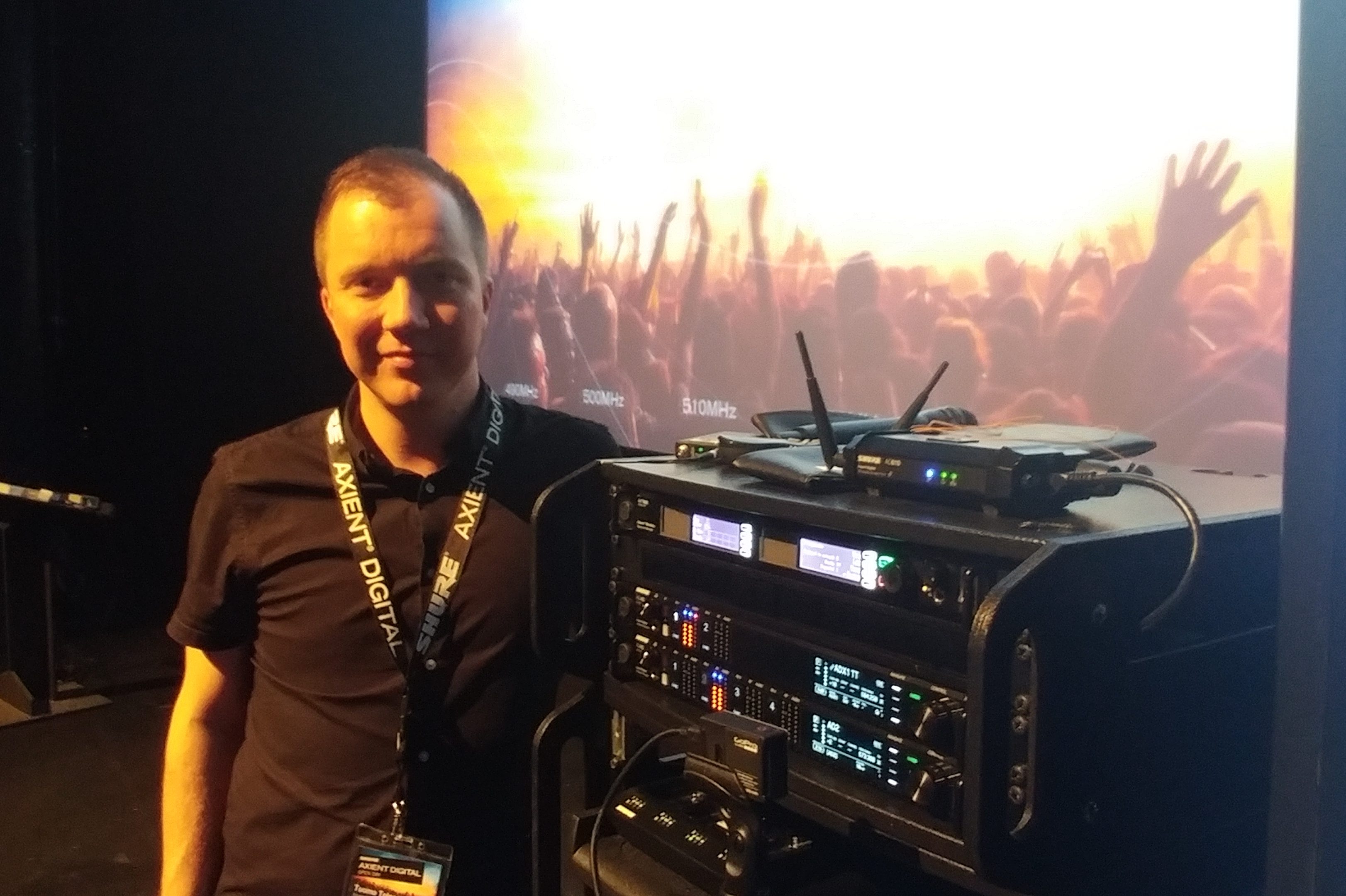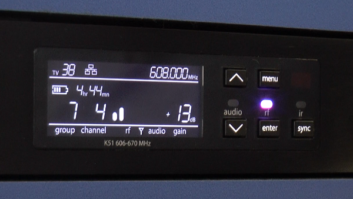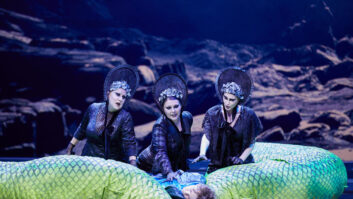
Paddy Baker gets an early demo of Shure’s new top-of-the-range wireless system, just a few weeks after it made its global demo at NAB.
I’ve been to countless venues in and around London for product demonstrations and press events over the years, but the Royal Academy of Dramatic Art – one of the UK’s oldest and most prestigious drama schools – was a first for me. Shure is a technology partner of RADA, and last month held a demo at its Jerwood Vanburgh Theatre for the new Axient Digital Wireless System.
Axient Digital is Shure’s top-of-the-range wireless system, superseding both the UHF-R and analogue Axient wireless systems. It was demonstrated by Shure’s Tuomo George-Tolonen, manager of the pro audio group at Shure Distribution UK.
“Axient Digital was designed for maximum signal stability, regardless of the environment you’re in,” said George-Tolonen, using it to talk to the audience throughout his presentation.
Signal quality
Many wireless products feature LEDs on the front panel showing signal strength – the amount of signal energy being received. Axient Wireless additionally has a five-bar channel quality meter on the front of the receiver. This information comes from the use of ‘pilot bits’ of a known amplitude and phase orientation; the receiver can discern any changes to these bits that have arisen during wireless transmission. When George-Tolonen switched on another transmitter on a nearby frequency, the quality meter reading fell. He contrasted analogue systems, which have a strong relationship between signal noise and carrier noise, giving some warning of when a signal is about to drop out, with digital systems, which “can sound great until the bitstream goes and hits the noise floor and it just disappears. The quality meter is another way of understanding the quality of the RF carriers.”
For Axient Digital, Shure has improved the capability of using multiple antennas to mitigate against signal loss. “If one antenna is only able to receive a portion of the bitstream, but the other antenna receives the missing information, the receiver is able to intelligently combine the information and reconstruct the audio.” The new Quadversity mode allows users to increase the number of antennas in a single zone to four. “You could pick the most critical channels in a show to run off a Quadversity antenna system – ensuing that they receive the maximum signal strength at all times – and everyone else just off two antennas.”
System latency, from the mic transducer to the analogue output, is an enviable 2ms. This can be improved even more – reduced by about 0.175ms – if digital outputs (Dante or AES) are used.
The Dante Browse function allows the receiver to search the network for any other Dante devices, such as stageboxes, or a laptop running Dante Via. Additionally, Dante Cue enables every Axient channel to be monitored via the receiver’s headphone socket.
Receivers and transmitters
The two receivers, AD4D (two-channel) and AD4Q (four-channel) have the same tuning bandwidths as the matching transmitters. The latter come in two series, AD and ADX. The AD1 bodypack and AD2 handheld transmitter (with interchangeable mic capsules), which resemble the equivalent products for the ULX-D range, will be available this summer. Enhanced functionality is offered by the ADX Series (coming early 2018), including remote controllability via ShowLink; this uses ZigBee to communicate with the transmitters in real time. “This is the device that informs the transmitters when we need to make a frequency change. The aim has always been that ShowLink gives the user access to the transmitters wherever the transmitters might be… you should be able to have Peter Pan flying through the middle of the show and if you need to change the frequency, you have access to that transmitter.”
As well as a bodyback transmitter (the ADX1, which resembles the AD1), there’s the streamlined ADX1M micro-bodypack “which is what we’re most excited about and has generated the most interest around Axient Digital,” said George-Tolonen. As well as being significantly smaller than the ADX1, it features a rounded design and uses two internal antennas.
How does the internal antenna compare with the traditional external ‘whip’ antenna? George-Tolonen explained that while a whip antenna is the best solution in a free field, its performance suffers when mass – such as a human body – is placed close to it. While the same is also true for internal antennas, the secondary antenna in the ADX1M continuously monitors the primary and retunes it for optimum performance. As a result, he said, “the Axient micropack outperforms any transmitter with an external antenna.”
Rounding off the transmitter choice are the ADX2 and ADX2FD handhelds, the latter being able to transmit on two discrete frequencies. “This is what Americans call the money mic – the one mic you cannot afford to lose in the middle of a show.”
At one point, George-Tolonen forced the system to change frequency in the middle of a sentence. I didn’t hear any break in his speech – apparently the changeover (to a carefully planned new frequency, not a random hop) took around 25-35ms.
In summary, I was highly impressed by Axient Digital. Shure has clearly put a lot of work into the many elements that make up the system, while leveraging its considerable expertise in getting the most out of the ever-shrinking RF spectrum available for wireless mics.







